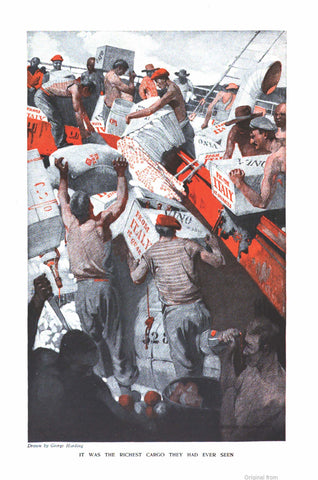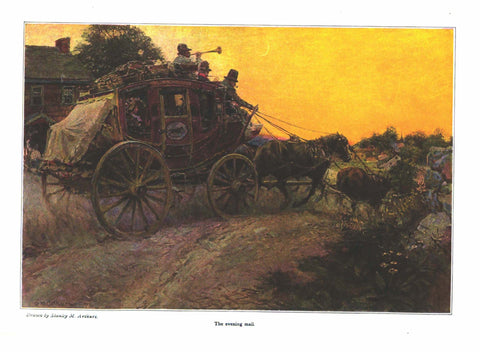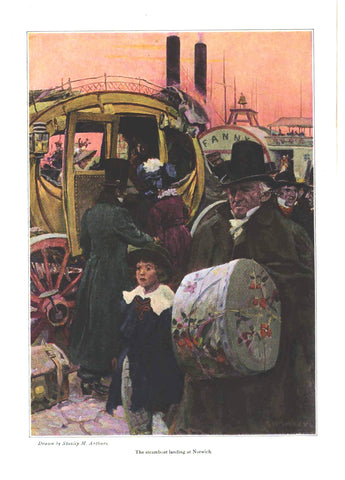Edward Penfield cover illustration for The Literary Digest (1909); a beautifully framed antique
$250.00
Cover: The Literary Digest
Knight, Scholar, and Damsel
By Edward Penfield
August 7, 1909 Issue
Vol. XXXIXX No. 6
IMAGE INFORMATION
Image Size: H 12.00” x W 9.00”
Matted & Framed: H 18.00” x W 15.00”
Framed Price: $250.00
Packaging and shipping approximately $22.00
In the fall of 1892, more than a year after EP joined its art staff, Harper and Brothers commissioned poster artist Eugène Grasset to create a poster-style cover for the Christmas issue of its monthly magazine.
EP evidently considered this new art form compatible with his own emerging style. In any case, he sought to capitalize on the emerging “poster design” trend by offering to produce another poster cover for the magazine. This image appeared on the cover of Harper’s Monthly Magazine’s April 1893 issue. It had poster characteristics in the sense that its graphics were simple and presented without composition. It featured flat fields of color without blending or shading. And it expressed its message without fanfare or embellishment. What distinguished it from a poster? It attracted the viewer’s gaze, but instead of promoting a product, it insinuated the theme of Harper’s April issue.
One of PE's biographers observed that “Penfield’s first poster to be widely published in the series was well received by the public — and by critics alike.” Herbert Stone, writing in The Chap-Book, explained that “it was unlike anything seen in the land before. It was a poster which forced itself upon one: in design and color it was striking, and yet it was supremely simple throughout. . . . it was theoretically as well as practically good. The artist had attained his ends by the suppression of details: there were no un-necessary lines.” [Ref: DFP, 321; Johnson, 231; Swann-2016, 5. Sited on https://edwardpenfield.com/catalogue/the-complete-harpers-posters/1893/.]
Well-known and highly regarded after ten years at Harper’s, EP found work creating covers and illustrations for Harper’s competitors, including Collier’s, Life, Scribner’s, The Saturday Evening Post, Outing Magazine, and other popular publications.
EP had established his reputation during the 1890s with his poster-designs. It seems odd therefore that after leaving Harper’s he abandoned the style. The reason for this sudden-seeming change may be that after a decade of nouveau art, the public was ready for something different. By the beginning of the new century, magazine-readers may have wanted a fresh look on their magazine covers.
EP had the artistic scope and was able to adjust his style to meet the changing taste of his audience. Instead of plowing farther into artistic design, which the essence of “the new art” (Art Nouveau), EP moved back toward his classical training. He did this by using his superior drafting skills to build simple, pleasing scenes. His mature works offered little in the way of composition, and his coloring was still done without blending or shading, but he added a quality of illustration by picturing episodes rather than impressions.
EP’s Literary Digest cover is an unusual example of his later line-based illustration style. EP typically depicted persons and events in “the real world.” Here, however, he portrays three handsome characters from the world of long ago and far away.
He has further deviated from his norm by dressing them in elaborate costumes, including a knight in a deftly contoured coat of armor with a plumed helmet and a damsel in a pleated gown and a stylish 15th century wimple. He has also staged the trio in a symmetrical composition, something he did not do elsewhere. By slightly tinting the characters’ ensembles in a three-color halftone, EP added distance and elegance to his scene.
This cover image has one more unusual feature: it appeared on several Literary Digest issues between February of 1909 and October of that year. Why TLD’s editor did this is not clear, and he did not do it after the fall of 1909. Perhaps he was using EP’s intriguing image to rebrand his twenty-year old publication.








